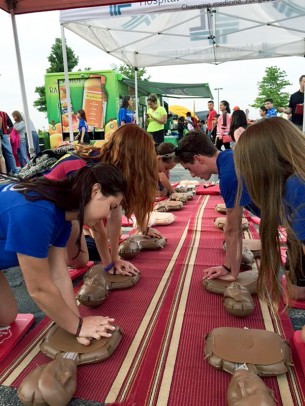Group provides CPR training kits to all Illinois high schools
High school teachers throughout Illinois will receive CPR training-toolkits from Illinois Heart Rescue – a nonprofit dedicated to increasing survival for cardiac arrest.
The kits include DVDs in more than six languages that provide simple instruction in how to perform CPR and use automated external defibrillators (AEDs) to restart a stopped heart. Mannequins to practice chest compressions on are also included.
The kits, which will be sent to Illinois’ regional offices of education, will be shared among local schools to help train the state’s 700,000 high school students.
Illinois Heart Rescue, which operates under a five-year, $2.5 million grant from the Medtronic Foundation, is a statewide volunteer effort of EMS professionals, physicians, nurses, community groups, hospitals and governmental agencies.
“Immediate CPR, performed by a bystander, is the best chance a person has at surviving a sudden cardiac event,” says the University of Illinois at Chicago’s Dr. Terry Vanden Hoek, professor and head of emergency medicine at UIC and project leader for Illinois Heart Rescue.
Since the program launched two years ago, Illinois Heart Rescue has trained thousands of Illinoisans in CPR and the use of AEDs, and in that time the statewide survival rate for out-of-hospital sudden cardiac arrest doubled, from 4 percent to 8 percent.
But bystander knowledge of CPR still varies across the state. Last year, when then-Gov. Pat Quinn signed the Lauran Laman Bill into law, mandating that all high school students receive CPR training, Illinois Heart Rescue saw an opportunity to further increase statewide survival for cardiac arrest.
“In some communities, we estimate that up to 30 percent of people know how to perform CPR, while in other communities, knowledge of CPR is very low,” Vanden Hoek said. “That’s why training high school students throughout the state in how to perform CPR is so important – it’s a chance to increase knowledge of CPR in all communities, which will further improve our state survival rate for out-of-hospital cardiac arrest.”
Lauren Laman was a 17-year-old from St. Charles, Illinois, who collapsed during dance practice at school. CPR was not given before emergency medical responders arrived. A nearby AED was not used.
“We wanted to help support the implementation of the Lauren Laman Law, which is an unfunded mandate, by taking the financial and training burden off Illinois schools, and decided the best way to do this would be to provide training toolkits teachers can use to not only learn how to perform CPR and use AEDs, but how to train others in the use of these life-saving techniques,” said Teri Campbell, senior research specialist in the University of Illinois College of Medicine emergency medicine department and director of Illinois Heart Rescue.
“Because Illinois Heart Rescue firmly believes in a ‘pay-it-forward’ model, we include handouts in the training kits that students can use to train their families in CPR at home,” said Campbell. “We ask that every student we train, in turn, teaches five additional people how to perform CPR.”
For more information on Illinois Heart Rescue, and to learn how to perform compression-only CPR, visit http://illinoisheartrescue.com

